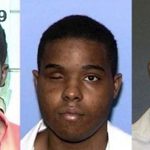
Andre Thomas (pictured) is a Texas death-row prisoner riven with schizophrenia so severe that, in separate incidents, he gouged out both of his eyes and ate one of them. The U.S. Court of Appeals heard oral argument on February 5, 2020, about whether his conviction and death sentence should be overturned because his lawyers failed to present evidence that he was incompetent to be tried, failed to present mitigating evidence of Thomas’ extensive history of mental illness, and failed to object to the seating of several jurors whose questionnaires exhibited overt racial bias.
Thomas is a Black man convicted of killing his white estranged wife, their biracial four-year-old son, and her biracial one-year-old daughter by a different father. He admitted to the murders, telling police that God told him to do it because his wife was Jezebel, his son was the anti-Christ, and the one-year-old was “an evil being.” He stabbed himself after the murders, but survived. In the three weeks before the murders, he intentionally overdosed twice, stabbed himself, and asked employees at a mental health facility to kill him.
Thomas’ appeal lawyers also attempted to challenge his eligibility to be sentenced to death, citing his severe mental illness. However, the Texas federal district court and the Fifth Circuit denied them permission to appeal that issue.
“A guy pulled out both his eyes and ate one of them,” said Christina Swarns, president and attorney-in-charge of the Office of the Appellate Defender in Manhattan and former litigation director of the NAACP Legal Defense and Educational Fund. “That is the conversation we should be having. What should happen to Andre Thomas because he is severely mentally ill, not should we be killing him.”
The Impact of Race in the Andre Thomas Case
The crime took place in Sherman, Texas, a town where a dramatic lynching and riot took place in 1930, after a Black farmhand named George Hughes was accused of raping a white woman. A white mob dragged Hughes behind a car, hung him from a tree in the Black business district, and set his body on fire. The Black business district was burned to the ground, martial law was declared, and the National Guard was called in to quell the rampage, remaining to police Sherman for the next two weeks. Only two men were convicted for their actions, one for rioting and one for arson. Each served a two-year sentence. The impact on the African-American community continued for generations: no Black lawyer or doctor practiced within the boundaries of Sherman for the next 65 years.
It was in that historical context that Thomas was tried by an all-white jury that included three members and an alternate juror who professed their opposition to interracial relationships. One said in their juror questionnaire that they “vigorously” opposed such relationships, adding “I don’t believe God intended for this.” Another stated, “We should stay with our bloodline.” Thomas’ attorneys did not object to them being seated on the jury. At the trial, the prosecutor explicitly stoked the jurors’ racial fears, asking them to consider “Are you going to take the risk about him asking your daughter out, or your granddaughter out?” if Thomas was paroled.
Though Thomas pleaded not guilty by reason of insanity, his trial lawyers presented little evidence of his family history of abuse and mental illness. Thomas first reported hearing frightening voices as early as age nine. Prosecutors successfully argued against the insanity defense by saying that Thomas was willingly intoxicated at the time of the crime. “Andre Thomas committed horrific crimes. But he did so in the throes of acute psychosis,” his appellate lawyers wrote in their brief. “His case exemplifies the injustice that occurs when counsel utterly fails to provide competent assistance.”
“Without the racial component in (the Thomas) case, it’s hard to imagine prosecutors would have sought the death penalty against somebody so obviously mentally ill or that a jury would have been willing to return the death penalty against somebody so mentally impaired,” said Jordan Steiker, director of the University of Texas School of Law Capital Punishment Center.
Swarns, who persuaded the U.S. Supreme Court to overturn the death sentence imposed on Duane Buck in Texas after his own defense lawyer presented an expert witness who said Buck would pose an increased risk of future violence because he is Black, noted that Thomas’ case presented a similar core issue. “Turning a blind eye to racial discrimination in this case sends a terrible message about our criminal justice system and what people of color are entitled to or should expect from the criminal justice system,” she said.
Brandi Swicegood, Jurors swayed by racism in Texas death penalty case?, Austin American-Statesman, February 5, 2020; Andrew Cohen, He Pocketed His Victims’ Organs. Was His Death Penalty Trial Fair?, The Marshall Project, June 7, 2018; Marc Bookman, How Crazy Is Too Crazy to Be Executed?, Mother Jones, February 12, 2013; Brandi Grissom, Trouble in Mind, Texas Monthly, February 12, 2013.
Mental Illness
Dec 05, 2024
Hidden Casualties: Executions Harm Mental Health of Prison Staff
Mental Illness
Nov 08, 2024

